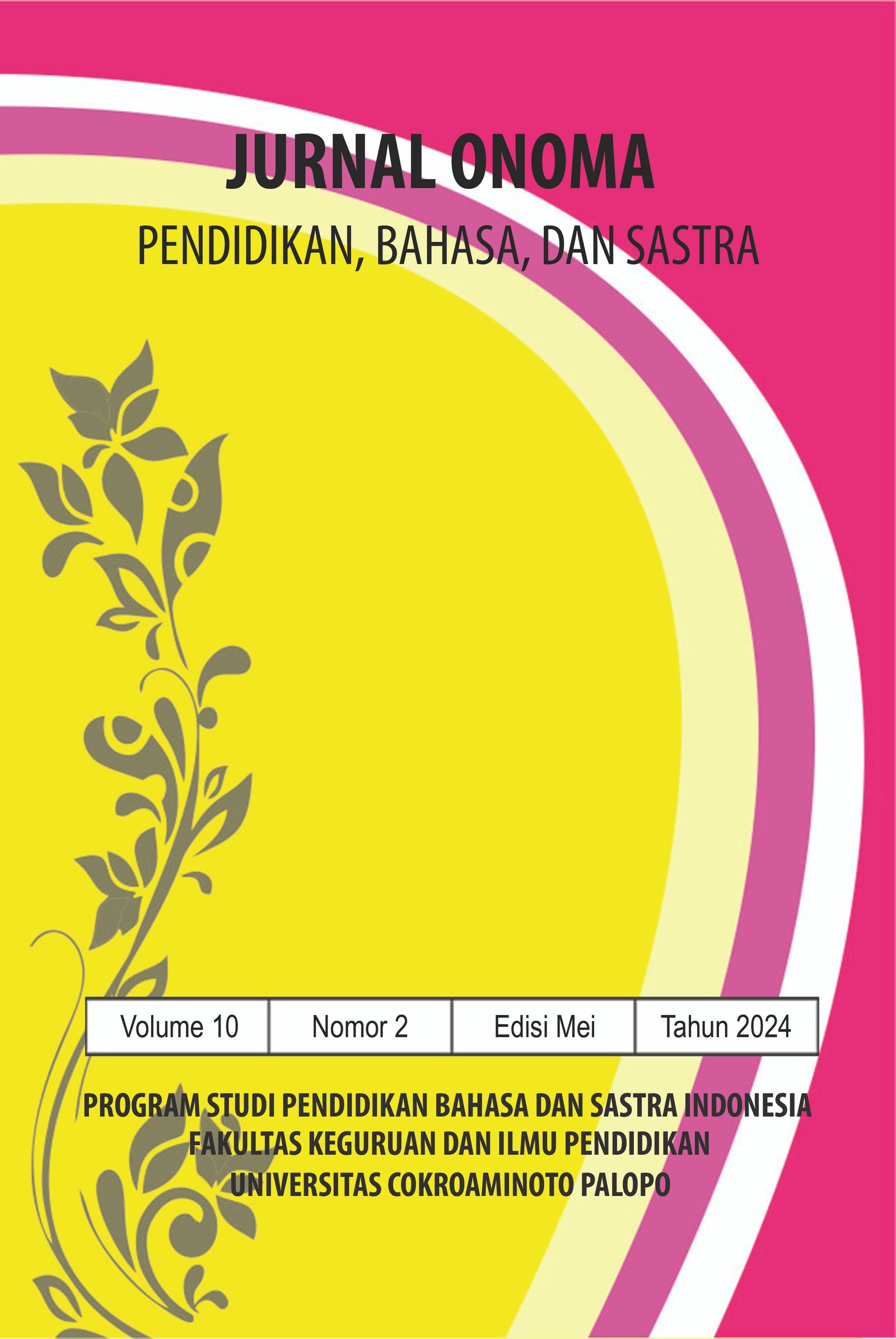Tialo Language Affix for Verb Marker
https://doi.org/10.30605/onoma.v10i2.3194
Keywords:
affixes, verbs, Tialo languageAbstract
The problems in this study are the types, meanings, and forms of affixes marking the Tialo language verbs. This study aims to describe the types, meanings, and forms of the Tialo language, including prefixes, suffixes, infixes, and confixes. The method used is a qualitative method. This study used the observing and speaking methods, with tapping techniques, proficient involvement techniques, proficient free observing techniques, fishing techniques, all-encompassing techniques, and note-taking techniques. The data analysis technique used is the distributional and equivalent method using the smallest element breakdown technique. Based on the results of research that has been carried out, it was found that affixes are markers for Tialo language verbs which include: Prefixes {moN-}, {non-}, {meN-}, {neN}, {poN-}, {peN-}, {in-}, and {te-}. {in-} infix. Suffixes {i-} and {a'a}. Confixes {moN-a'a} {noN-a'a}, {meN-a'a}, {meN-omo}, {nen-omo}, {poN-omo} and {moN-i}. The meaning of the affix markers in the Tialo language is going to take action, is taking action, has taken action, ordered, has taken action for others, and has finished taking action for others. Meanwhile, the affixes for the Tialo language consist of prefixes {mo-}, {no-}, and {me-}. {in-} infix. Suffixes {-i} and {a'a}. The confixes {mo-i}, {mo-a'a}, and {no-a'a} in the affix form of the Tialo language verb markers have changed and some have not changed.
Downloads
References
Arifin, S. R. M. (2018). Ethical considerations in qualitative study. International journal of care scholars, 1(2), 30-33. DOI: https://doi.org/10.31436/ijcs.v1i2.82
Aronoff, M. (2019). Competitors and alternants in linguistic morphology. Competition in inflection and word-formation, 39-66. DOI: https://doi.org/10.1007/978-3-030-02550-2_2
Aronoff, M., & Fudeman, K. (2022). What is morphology?. John Wiley & Sons.
Blust, R. (2011). The problem of doubleting in Austronesian languages. Oceanic Linguistics, 399-457. DOI: https://doi.org/10.1353/ol.2011.0015
Blust, R. A. (2004). Sourcebook on Tomini-Tolitoli languages: General information and word lists. Oceanic Linguistics, 43(2), 525-530. DOI: https://doi.org/10.1353/ol.2005.0002
Bonami, O., Crysmann, B., Hippisley, A., & Stump, G. T. (2016). Morphology in constraint-based lexicalist approaches to grammar. The Cambridge handbook of morphology, 609-56. DOI: https://doi.org/10.1017/9781139814720.022
Himmelmann, N. P. (2001). Voice in two northern Sulawesi languages. In The history and typology of western Austronesian voice systems. Pacific Linguistics.
Khodabandelou, R., That, J. E. M., Ken, T. Y., Kewen, Z., Yan, Z., & Ning, T. Y. (2016). Exploring the Main Barriers of Technology Integration in the English Language Teaching Classroom: A Qualitative Study. International Journal of Education and Literacy Studies, 4(1), 53-58. DOI: https://doi.org/10.7575/aiac.ijels.v.4n.1p.53
Mayani, L. A. (2013). A grammar of Tajio. a language spoken in Central Sulawesi (Doctoral dissertation, Universität zu Köln).
McQueen, J. M., & Cutler, A. (2017). Morphology in word recognition. The handbook of morphology, 406-427. DOI: https://doi.org/10.1002/9781405166348.ch21
Moro, F. R. (2010). A Sketch Grammar of Dampelas, a Language of Central Sulawesi (Doctoral dissertation, MA Thesis, The University of Leiden).
Natow, R. S. (2020). The use of triangulation in qualitative studies employing elite interviews. Qualitative research, 20(2), 160-173. DOI: https://doi.org/10.1177/1468794119830077
Suparman, S., Nurahmad, M., & Muklim, M. (2023). Transkripsi Fonetik Cerita Rakyat Luwu. DEIKTIS: Jurnal Pendidikan Bahasa dan Sastra, 3(3), 155-161. DOI: https://doi.org/10.53769/deiktis.v3i3.526
Quick, P. (2008). A grammar of the Pendau language of central Sulawesi, Indonesia. Pacific Linguistics, Research School of Pacific and Asian Studies, The Australian National University.
Sharifian, F. (2017). Cultural linguistics. Cultural Linguistics, 1-189. DOI: https://doi.org/10.1007/978-981-10-4056-6_1
Taboada, M. (2016). Sentiment analysis: An overview from linguistics. Annual Review of Linguistics, 2, 325-347. DOI: https://doi.org/10.1146/annurev-linguistics-011415-040518
Downloads
Published
How to Cite
License
In submitting the manuscript to the journal, the authors certify that:
- They are authorized by their co-authors to enter into these arrangements.
- The work described has not been formally published before, except in the form of an abstract or as part of a published lecture, review, thesis, or overlay journal.
- That it is not under consideration for publication elsewhere,
- That its publication has been approved by all the author(s) and by the responsible authorities – tacitly or explicitly – of the institutes where the work has been carried out.
- They secure the right to reproduce any material that has already been published or copyrighted elsewhere.
- They agree to the following license and copyright agreement.
License and Copyright Agreement
Authors who publish with Onoma Journal: Education, Languages??, and Literature agree to the following terms:
- Authors retain copyright and grant the journal right of first publication with the work simultaneously licensed under Creative Commons Attribution License (CC BY 4.0) that allows others to share the work with an acknowledgment of the work's authorship and initial publication in this journal.
- Authors are able to enter into separate, additional contractual arrangements for the non-exclusive distribution of the journal's published version of the work (e.g., post it to an institutional repository or publish it in a book), with an acknowledgment of its initial publication in this journal.
- Authors are permitted and encouraged to post their work online (e.g., in institutional repositories or on their website) prior to and during the submission process, as it can lead to productive exchanges, as well as earlier and greater citation of published work.

















